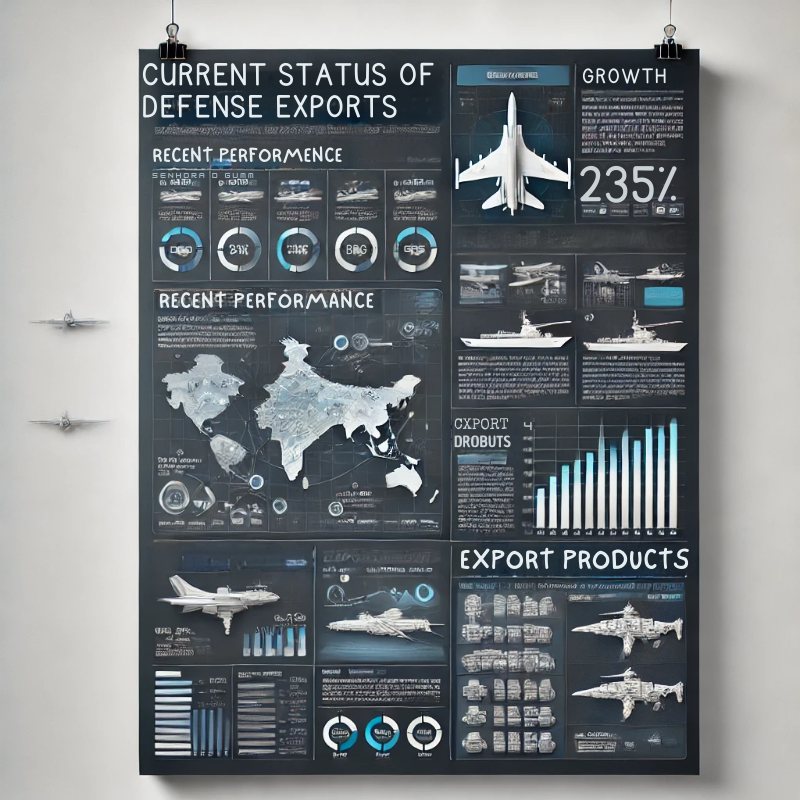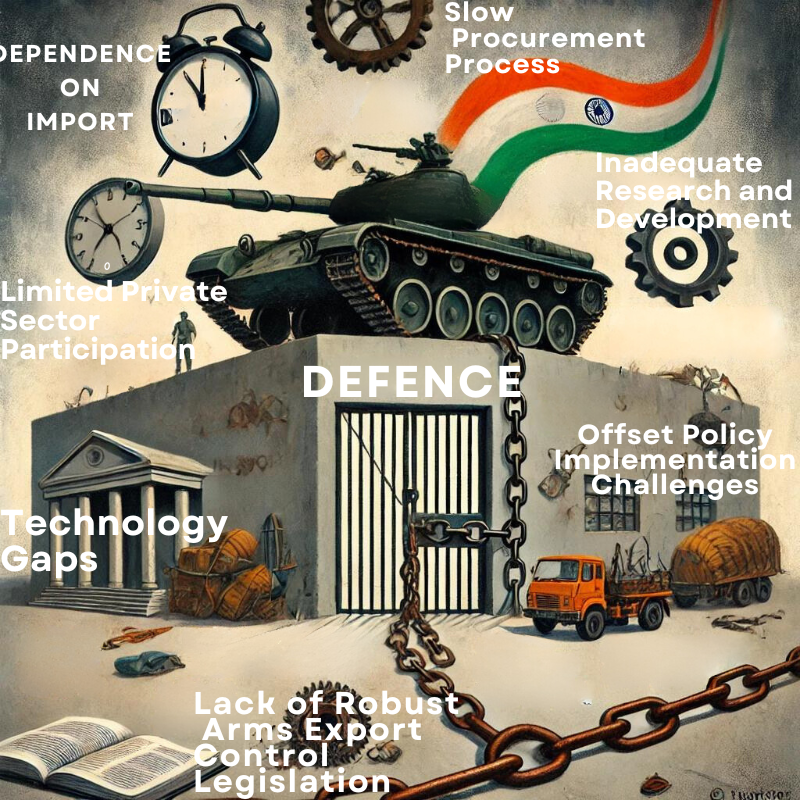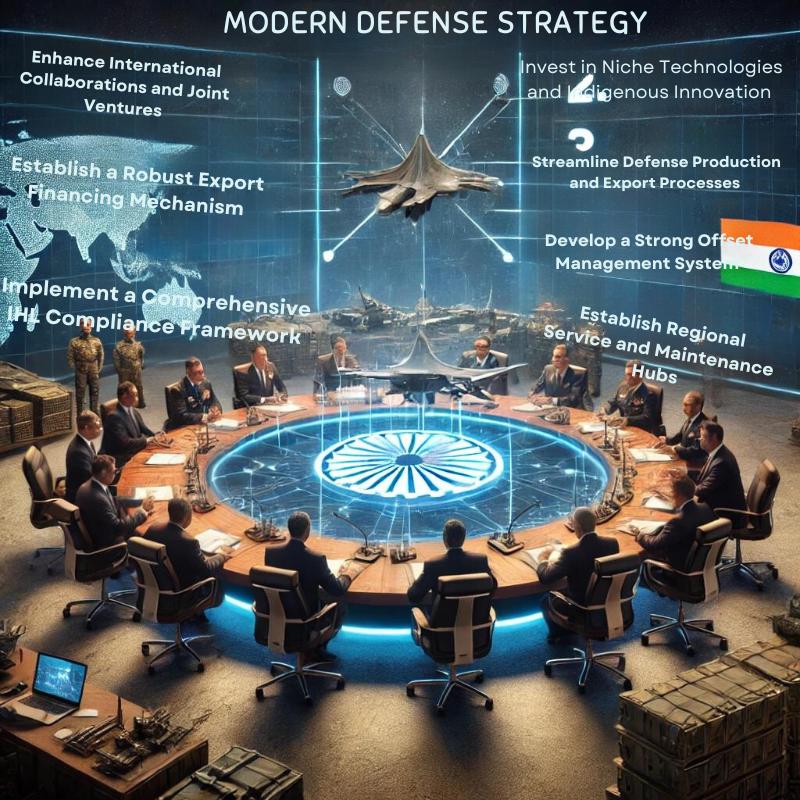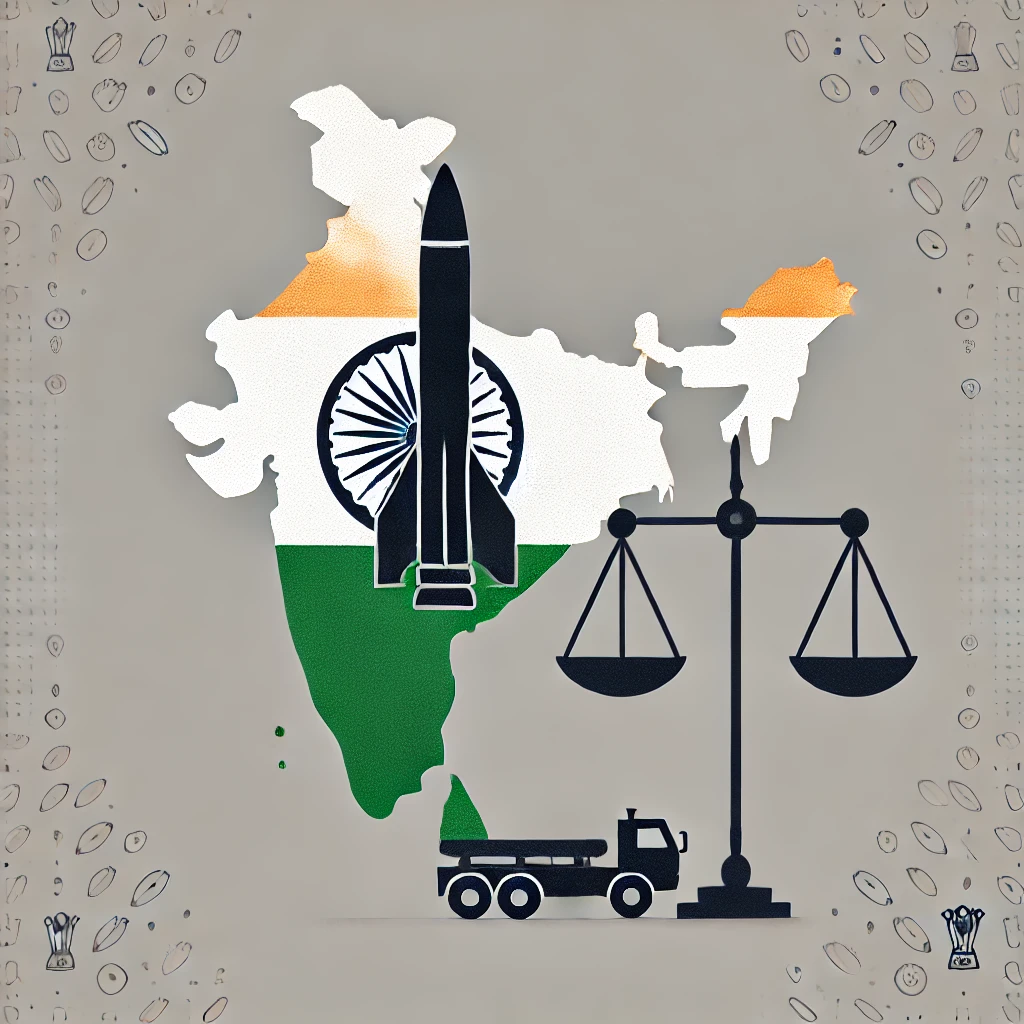India defense sector is booming on the motto of self-reliance and indigenization. However, this new surge in the arms market across the world raises many legal and ethical questions on the horizon in India. Recently, a case against arms exports to Israel was dismissed by the Supreme Court, despite cases of war crimes, where the issue shows the gap in the legal framework of India. India lacks reviews over the compliance of IHL unlike the Netherlands and the UK. Therefore, it would preserve India from reputational losses and simultaneously try to contribute to the international community’s efforts towards non-abuse of weaponry.
| GS Paper | GS Paper III |
| Topics for UPSC Prelims | India’s Defense sector, Supreme Court, BrahMos missiles, Defence Production and Export Promotion Policy, Innovations for Defence Excellence, Defence Research and Development Organisation, Advanced Light Helicopter, Defence Procurement Procedure. |
| Topics for UPSC Mains | Growth Drivers of India’s Defense Exports, Major Issues Related to India’s Defence Sector. |
Origin of the Article
This editorial is based on “India’s defense exports and humanitarian law” published in The Hindu on 24/09/2024. It discusses the legal and ethical gaps in India’s defense exports, emphasizing the need for comprehensive legislation to ensure responsible arms exports.
Relevance for UPSC Aspirants
This is a very important topic for UPSC aspirants since it falls under GS Paper 2: Government Policies & Interventions and GS Paper 3: Achievements of Indians in Science & Technology, Defense Technology. It provides insights into the defense policies of India, international law, and ethical governance and in doing so would be an on-the-job learning experience to understand every contemporary issue holistically.
Why in News?
Indian defense export policies, an aspect to which India can also relate very much to International Humanitarian Law (IHL), indicate some large legal and ethical lacunas. The subject is essential for the aspirants of UPSC as it deals with GS Paper 2 (Government Policies) and GS Paper 3 (Defense Technology). Recently, controversies surrounding India’s arm export regulations have found a lot of relevance to earlier UPSC questions upon defense procurement and international agreements, more for critical implications to national security and global diplomacy.

Current Status of India’s Defense Exports
Indian defense export policies, an aspect to which India can also relate very much to International Humanitarian Law (IHL), indicate some large legal and ethical lacunas. The subject is essential for the aspirants of UPSC as it deals with GS Paper 2 (Government Policies) and GS Paper 3 (Defense Technology). Recently, controversies surrounding India’s arm export regulations have found a lot of relevance to earlier UPSC questions upon defense procurement and international agreements, more for critical implications to national security and global diplomacy.
Recent Performance
The development of defense exports in India rose to the level of ₹6,915 crore in the first quarter of FY 2024-25, a growth of 78% over ₹3,885 crore in the same period of the last fiscal. A quantum jump like this shows the nation’s increasing footprint in the global defense market and reflects the enhanced production capabilities of India and its strategic export initiatives.
Growth Trajectory
Indian defense exports have grown by more than 12 times since FY 2017 and 31 times from FY 2013-14. The trend has placed India amongst the world’s top 25 arms-exporting nations, with its defense products reaching nearly 85 countries. Growth at this exponential level makes it clear that India’s role in the global defense sector is becoming increasingly emergent.
Export Products
India’s defense export portfolio has a broad range of products, which include Dornier-228 aircraft, BrahMos missiles, PINAKA rockets, radars, armored vehicles, and a variety of surveillance systems. This wide array of high-quality, competitively priced defense equipment has made India a preferred supplier for many countries, particularly in the developing world.
Growth Drivers of India’s Defense Exports
Policy reforms, increased participation by the private sector, focus on research and development, strategic partnerships, competitive pricing, and an effective offset policy have been the major driving forces behind the steady increase in India’s defense exports.
Policy Reforms and Government Initiatives
The government has introduced very robust policy reforms to stimulate defense exports. The most recent one is the Defence Production and Export Promotion Policy (DPEPP) 2020, which targets a turnover of USD 25 billion in defense manufacturing by 2025. In addition to these, increased FDI limits, Make in India, Atma Nirbhar Bharat, and Positive Indigenization Lists have further fueled indigenous production and exports.
Increased Private Sector Participation
High-Level Justification: The sector opened up to the private players and it has shown a great impetus in export growth. Innovations for Defence Excellence, or iDEX, and Defense Industrial Corridors have promoted the involvement of the private sector. Among them is Tata Advanced Systems’ aerospace component export which signifies the diversification and competitiveness of the sector.
Focus on Research and Development
Indian R&D in the defense area is strengthened to a level that has become advanced in this sector. DRDO remains one of the main organizations that utilize a reasonable budget for defense research and development activities. Good examples of success gained through domestic R&D include BrahMos missile systems and Akash air defense systems, which make India a stronger competitor in global markets.
Strategic Partnerships and Government-to-Government Agreements
Defense exports in India have characterized government-to-government agreements and strategic partnerships. Such agreements include the India-Japan Acquisition and Cross-Servicing Agreement (ACSA) as well as defense cooperation with more than 53 other countries. Indian defense products gain a new market in collaboration with the partner nations in the production and exportation of their defense products.
Competitive Pricing and Quality
Indian defense products have good quality with competitive pricing and would appeal to many developing and middle-income countries. Lower manufacturing costs combined with an emphasis on cost-effective solutions, such as the Akash missile system, provide a high-value proposition, which enhances India’s export appeal.
Offset Policies and Technology Transfer
India has an offset policy, whereby part of the contract value of defense companies from abroad must go into investment in India. This way, many exports boost and Indian manufacturers’ capabilities through joint ventures: Tata-Lockheed Martin for F-16 wing sets.

Major Issues Related to India’s Defence Sector
Despite making significant strides forward, the defense sector still faces significant challenges such as excessive dependence on imports, slow procurement processes, limited participation of private sector partners, inadequate R&D efforts, technology gaps, problems in implementing the offset policy, and a lack of stringent arms export control legislation.
Dependence on Imports
India is heavily reliant on foreign technology and equipment. A significant portion of arms imports, accounting for 9.8% of the world between 2019 and 2023, is done with major deals such as the S-400 air defense from Russia that are making the country heavily reliant on foreign technology, risking national security, and straining foreign exchange reserves.
Slow Procurement Process
The defense procurement process of India is abhorred for its mess and delays. The Defence Procurement Procedure, even after major revision, continues to be clumsy. However, the entire procurement process of MMRCA reflects the imperfections of the overall process. Thus, it does not contribute much toward timely modernization.
Limited Private Sector Participation
Despite high entries, it’s preferred that the public sector units participate and entry costs are high. In FY24, private companies were a mere 22 percent, as DPSUs took the share of major projects not letting private players have much of a chance to grab.
Inadequate Research and Development
Part of the reason why India’s defense R&D lags behind world leaders is that despite increased budget allocations, it remains deficient. India just could not possibly put up with the prolonged cost overrun of a project like the Kaveri engine for the Tejas fighter jet. Now, one needs more robust R&D investments to make that elusive technological self-reliance.
Technology Gaps
Technology gaps are humongous in India, particularly in the core competency areas. The development of an engine and the development of complex materials are a couple of examples. Importing foreign content with the GE F404 for the Tejas fighter has implications regarding the technology gap and, by extension, implications for self-reliance as well as the chances of export of this aircraft.
Offset Policy Implementation Challenges
The offset policy of India has faced serious challenges. Even though the offset contracts scored very poorly in the CAG report, which revealed that only ₹11,396 crore was claimed out of the ₹66,427 crore offset contracts sanctioned between 2005 and 2018, the inefficiency and the missed opportunities are plentiful.
Lack of Robust Arms Export Control Legislation
India does not have, under its control system for arms exports, evaluation in respect of human rights records or the record of compliance with IHL by the recipient country. Such legislative lacunae underscored by the dismissal of the PIL against exports to Israel, thus, ran the risk of violating international law and even reputational damage.

Measures to Revamp India’s Defence Sector
Enhancing international collaborations must be complemented by robust export financing mechanisms, a comprehensive IHL compliance framework, investing in niche technologies, streamlining production and export processes, developing a strong offset management system, and establishing regional service and maintenance hubs for India to revamp its defense sector and boost exports.
Enhance International Collaborations and Joint Ventures
India must pursue strategic partnerships as well as joint ventures with global defense manufacturers. Even co-production facilities, technology transfer agreements, and collaborative R&D projects would strengthen technological capabilities and export potential as in the case of the HAL-GE agreement on F414 engines.
Establish a Robust Export Financing Mechanism
Mechanisms specifically designed for defense exports must be developed to support these. Government-guaranteed loans and credit lines at a competitive rate and insurance against all risks can make Indian defense products more attractive, particularly in developing countries, thus spurring export competitiveness.
Implement a Comprehensive IHL Compliance Framework
Mechanisms specifically designed for defense exports must be developed to support these. Government-guaranteed loans and credit lines at a competitive rate and insurance against all risks can make Indian defense products more attractive, particularly in developing countries, thus spurring export competitiveness.
Invest in Niche Technologies and Indigenous Innovation
Mechanisms specifically designed for defense exports must be developed to support these. Government-guaranteed loans and credit lines at a competitive rate and insurance against all risks can make Indian defense products more attractive, particularly in developing countries, thus spurring export competitiveness.
Streamline Defense Production and Export Processes
Streamlining Defense Production and Exports is the need of the hour. A single window clearance system, simplified licensing procedures, and dedicated export promotion cells can be used to improve efficiency and competitiveness with less time taken and more representation in the global markets.
Develop a Strong Offset Management System
There can be offset policy renovation and proper management system development with significant leverage on defense imports to boost exports. Capability in manufacturing and export potential is further enhanced through the agency of offset management, a transparent online platform, and alignment with export-oriented projects.
Establish Regional Service and Maintenance Hubs
The establishment of regional service and maintenance hubs at strategic locations can increase the attractiveness of Indian defense exports. Moreover, additional revenues can be obtained with on-site after-sales support and upgrades/maintenance, while long-term relationships are built up, even as such hubs in Vietnam and UAE position for strategic regions.
PESTEL Analysis
| Political: India’s defense exports are driven by government initiatives like the Defence Production and Export Promotion Policy (DPEPP) 2020. These policies aim to strengthen self-reliance. However, balancing arms exports with global diplomatic relations, especially with countries having questionable human rights records, remains politically sensitive. Economic: India’s defense exports reached ₹6,915 crore in the first quarter of FY 2024-25, reflecting a 78% increase. Growth is driven by competitive pricing and quality. Despite advancements, India remains reliant on importing critical technologies, highlighting the need for further economic independence in defense manufacturing. Social: The growth of India’s defense sector promotes national pride, job creation, and technological progress. Initiatives like ‘Make in India’ encourage local industries. However, ethical concerns arise regarding defense exports to nations with poor human rights records, impacting India’s global reputation and diplomatic relations. Technological: India’s defense sector has advanced with indigenous technologies like the BrahMos missile system, but gaps remain, especially in engine production. Collaborative ventures and technology transfers are helping bridge these gaps, but India must continue investing in research and innovation to achieve self-reliance in critical defense technologies. Environmental: India’s growing defense sector must consider its environmental impact. As production increases, sustainable practices should be integrated into defense manufacturing. The global trend toward eco-friendly technologies offers an opportunity for India to adopt green processes without compromising on defense output or technological advancements. Legal: India lacks robust arms export control laws that ensure compliance with International Humanitarian Law (IHL). This absence creates legal and ethical risks in global arms sales. Strengthening legal frameworks, particularly around export controls and offset policies, is crucial for aligning defense exports with international legal standards. |
Conclusion
This makes legal and ethical gaps, especially on IHL compliance, even more relevant to the quest of becoming an important player for India in the global defense market. Institution of a comprehensive legislative regime, encouragement of innovative strategies, and providing India with enhanced responsibility as an arms exporter would ensure its defense ambitions conform to global standards. Hence, this strategic approach will no doubt enhance national security but also place India at the forefront of mainstreaming defense international lay landscapes.
| UPSC Civil Services Examination, Previous Year Questions (PYQs) Mains Q. In recent years, India has been making strides toward self-reliance in defense production. Discuss the measures taken by the government to enhance defense manufacturing capabilities and the challenges that lie ahead. (2022, GS Paper-III) Q. Discuss the innovations brought by the Defence Research and Development Organisation (DRDO) and initiatives like Innovations for Defence Excellence (iDEX). How are these contributing to India’s goal of becoming self-reliant in the defense sector? |


